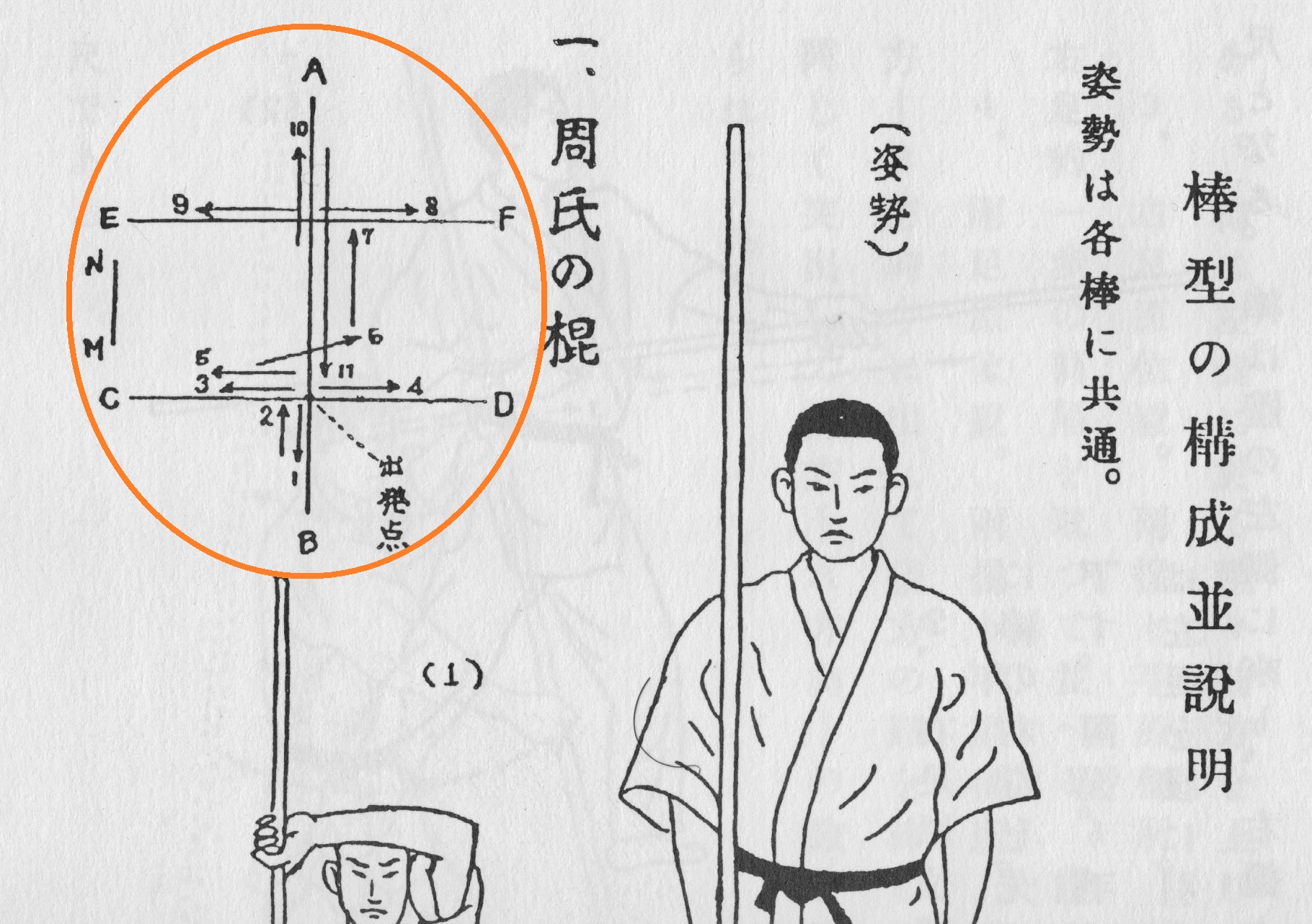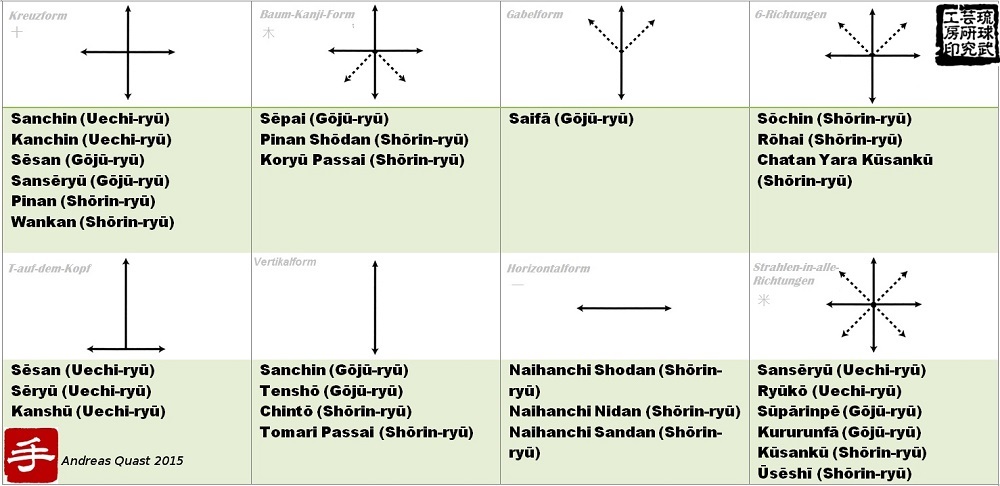The following is a short text I have translated from the Encyclopedia of Okinawa Karate and Kobudo. It was written by senior Uechi-ryū practitioner Tōbaru Keichō. It gives a quite good overview abut the topic of enbusen.
With uke-waza (defenses), tsuki-waza (strikes), and keri-waza (kicks) at its externally visible nucleus, the kata of Karate also inherently include skills such as tsukame-waza (seizing), nage-waza (throwing), and kansetsu-waza (joint locking, grappling).
In addition, every kata has a so-called enbusen 演武線, or “trajectories of martial kata performances”. Assuming attacks from the front, back, left and right, and performing defenses, strikes, and kicks etc. against a visualized opponent, individual techniques (=dots) are being combined into a series of techniques (=a line). Kata is the representation of all dots and lines systematized as a whole. The course of the footwork used to perform these attacks and defenses are the enbusen.
Envisioning effective and appropriate techniques of offense and defense against opponents from all directions, and integrating it with footwork into a series of movements, the performance of the enbusen is one of the key elements for the acquisition of techniques in Karate.
As the basic forms of enbusen, there is the ‘I-shaped enbusen‘ (ijikei) which assumes the enemy in the front and back, the ‘horizontal enbusen‘ (yokoichijikei) which assumes the enemy on the left and right, the ‘cross-shaped enbusen‘ (jūjikei) which assumes the enemy from four directions, the ‘all directions enbusen‘ (shihōhappō) which assumes the enemy in all directions, and the ‘enbusen in which the directions and footwork radiates to all directions’ (happō hōshakei). Additionally, depending on the type of kata, various other enbusen exist, such as the ‘T-shaped’ (teijikei), the ‘reversed-T-shaped’, and the ‘tree-kanji-shape’ (kijikei) enbusen.
In addition to the aesthetic or practical ideas of the inventor, from the perspective of larger and smaller training places as well as from the specific martial arts tradition, the starting point and the end point of the enbusen – referred to as matomari 纏まり in the Japanese language, meaning both consistency and conclusion – have to be consistent. That is, the start and end points are assumed to have been designed so as to return to the original starting spot when finishing the kata. However, due to differences in the physique, expressive power, stepping, footwork of the performer, the start and end point are not always exactly consistent. Especially in old kata of Kobudō, such a consistency in the start and end points is even harder to find. Therefore, this consistency might be a more modern necessity.
While there are various trajectories based on the inventor’s viewpoint and ideas of martial arts, none of the enbusen of kata shows large deviations from the standard. Every kata includes a martial performance flowing along the enbusen, and even if there is some deviation, the kata ends within the radius of about 1 meter from the starting point. As a part of traditional kata, together with functionality and combative characteristics, the matomari has become something for handing down information.
There are some things to consider when it comes to pre-1900 ‘Karate‘.
First of all, while the (almost) identical start and end point is certainly a classic feature of kata in Karate, the term matomari 纏まり doesn’t seem to be that old. Rather, it appears to be a loan word taken from general-language and adopted into the special language of Karate rather recently.
Secondly, there are various possible reasons for the (almost) identical start and end point. For example, one might argue that it is the result of boundaries, such as in indoor training or when training larger groups of people. This is valid for the era of the conscription agers’ Karate of Itosu et.al. but also for the cases of public performances of martial arts, such as in case of visits by Chinese investiture envoys (Sappōshi), where stages were used, just as in case of musical or theatrical performances inside Shuri castle.
Thirdly, when practice or performances took place on Uganju 御願所, there was more free space than on a stage. However, most of the time there was an audience who were positioned according to hierarchy. For example, the village elders at the Uganju, or guests of honor during performances for Sappōshi, the order of people during performances on stages set up inside Shuri castle, the gymnastics teachers at school Karate practice, etc.
BTW, while in Kobudō the same concept of enbusen is used, start and end point do not match as clearly as in Karate .

Enbusen of “Shūji no Kun”. From: Miki Jisaburô, Takada Mizuho: Kenpô Gaisetsu, 1930, page 153.
There might also have simply been an aesthetic reason for it.
While it seems that in Kobudō the start and end point are not as clearly the same as in Karate, the question remains when exactly enbusen where begun to be choreographed around an almost identical start and end point, or if this is just a comparatively new fashion every martial arts from Okinawa had been subjected to since the early 20th century or so. It is true that modern Karate in Okinawa was a development that followed and ultimately replaced Western style military drill (heishiki taisō) in the Okinawan school system. Hence, the enbusen of Karate and Kobudō as seen today might simply have been built around Western gymnastics popular in Japanese education and military at the end of the 19th century. In this connection, and with a very few exceptions, the obsession with a clear-cut personal genealogi-technical tree might best be replaced by the concept of a genealogi-technical bush.

A selection of Enbusen or demonstration diagrams.
Biblio
- Okinawa Karate Kobudō Jiten 2008: 197–198.
- Miki Jisaburō, Takada Mizuho(gemeinsame Hrsg.): Kenpō Gaisetsu. Nachdruck. Ginowan, Yōyu Shorin 2002. 284 Ss, 8 S. illustriert, 22cm. Anm.: Erstausgabe Wissenschaftliche Arbeitsgemeinschaft des Karate (Tōde) an der Kaiserlichen Universität Tōkyō, 1930: 153.
© 2017 – 2022, Andreas Quast. All rights reserved.
